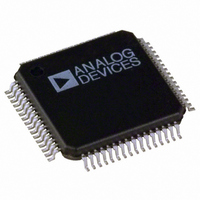ADE7166ASTZF8 Analog Devices Inc, ADE7166ASTZF8 Datasheet - Page 137

ADE7166ASTZF8
Manufacturer Part Number
ADE7166ASTZF8
Description
IC ENERGY METER 1PHASE 64LQFP
Manufacturer
Analog Devices Inc
Specifications of ADE7166ASTZF8
Applications
Energy Measurement
Core Processor
8052
Program Memory Type
FLASH (8 kB)
Controller Series
ADE71xx
Ram Size
512 x 8
Interface
I²C, SPI, UART
Number Of I /o
20
Voltage - Supply
3.135 V ~ 3.465 V
Operating Temperature
-40°C ~ 85°C
Mounting Type
Surface Mount
Package / Case
64-LQFP
Ic Function
Single Phase Energy Measurement IC
Supply Voltage Range
3.13V To 3.46V, 2.4V To 3.7V
Operating Temperature Range
-40°C To +85°C
Digital Ic Case Style
LQFP
No. Of Pins
64
Lead Free Status / RoHS Status
Lead free / RoHS Compliant
Available stocks
Company
Part Number
Manufacturer
Quantity
Price
Company:
Part Number:
ADE7166ASTZF8
Manufacturer:
Analog Devices Inc
Quantity:
10 000
Company:
Part Number:
ADE7166ASTZF8-RL
Manufacturer:
Analog Devices Inc
Quantity:
10 000
I/O PORTS
PARALLEL I/O
The ADE7566/ADE7569/ADE7166/ADE7169 use three
input/output ports to exchange data with external devices. In
addition to performing general-purpose I/O, some are capable of
driving an LCD or performing alternate functions for the
peripherals available on-chip. In general, when a peripheral is
enabled, the pins associated with it cannot be used as a general-
purpose I/O. The I/O port can be configured through the SFRs
in
Table 148. I/O Port SFRs
SFR
P0
P1
P2
EPCFG
PINMAP0
PINMAP1
PINMAP2
The three bidirectional I/O ports have internal pull-ups that can
be enabled or disabled individually for each pin. The internal
pull-ups are enabled by default. Disabling an internal pull-up
causes a pin to become open drain. Weak internal pull-ups are
configured through the PINMAPx SFRs.
Figure 114 shows a typical bit latch and I/O buffer for an I/O
pin. The bit latch (one bit in each port’s SFR) is represented as a
Type D flip-flop, which clocks in a value from the internal bus
in response to a write-to-latch signal from the CPU. The
Q output of the flip-flop is placed on the internal bus in response
to a read latch signal from the CPU. The level of the port pin
itself is placed on the internal bus in response to a read pin
signal from the CPU. Some instructions that read a port activate
the read latch signal, and others activate the read pin signal. See
the
INTERNAL
TO LATCH
Table 148.
Read-Modify-Write Instructions section for details.
LATCH
WRITE
READ
READ
BUS
PIN
Address
0x80
0x90
0xA0
0x9F
0xB2
0xB3
0xB4
Figure 114. Port 0 Bit Latch and I/O Buffer
LATCH
CL
D
Q
Q
Bit Addressable
Yes
Yes
Yes
No
No
No
No
ALTERNATE
ALTERNATE
FUNCTION
FUNCTION
OUTPUT
INPUT
DV
DD
CLOSED: PINMAPx.x = 0
OPEN: PINMAPx.x = 1
INTERNAL
PULL-UP
Description
Port 0 Register.
Port 1 Register.
Port 2 Register.
Extended Port
Configuration.
Port 0 Weak
Pull-Up Enable.
Port 1 Weak
Pull-Up Enable.
Port 2 Weak
Pull-Up Enable.
Px.x
PIN
Rev. A | Page 137 of 144
Weak Internal Pull-Ups Enabled
A pin with weak internal pull-up enabled is used as an input by
writing a 1 to the pin. The pin is pulled high by the internal pull-
ups, and the pin is read using the circuitry shown in
If the pin is driven low externally, it sources current because of
the internal pull-ups.
A pin with internal pull-up enabled is used as an output by
writing a 1 or a 0 to the pin to control the level of the output. If
a 0 is written to the pin, it drives a logic low output voltage
(V
Open Drain (Weak Internal Pull-Ups Disabled)
When the weak internal pull-up on a pin is disabled, the pin
becomes open drain. Use this open-drain pin as a high impedance
input by writing a 1 to the pin. The pin is read using the circuitry
shown in
inputs because it draws less current than the internal pull-ups
that were enabled.
38 kHz Modulation
Every ADE7566/ADE7569/ADE7166/ADE7169 provides a
38 kHz modulation signal. The 38 kHz modulation is
accomplished by internally XOR’ing the level written to the I/O
pin with a 38 kHz square wave. Then, when a 0 is written to the
I/O pin, it is modulated as shown in
Uses for this 38 kHz modulation include IR modulation of
a UART transmit signal or a low power signal to drive an
LED. The modulation can be enabled or disabled with the
MOD38EN bit in the CFG SFR. The 38 kHz modulation is
available on eight pins, selected by the MOD38[7:0] bits in the
Extended Port Configuration SFR (EPCFG, 0x9F).
OL
38kHz MODULATION
ADE7566/ADE7569/ADE7166/ADE7169
) and is capable of sinking 1.6 mA.
LEVEL WRITTEN
OUTPUT AT
Figure 114. The open-drain option is preferable for
MOD38 PIN
TO MOD38
SIGNAL
Figure 115. 38 kHz Modulation
Figure 115.
Figure 114.













